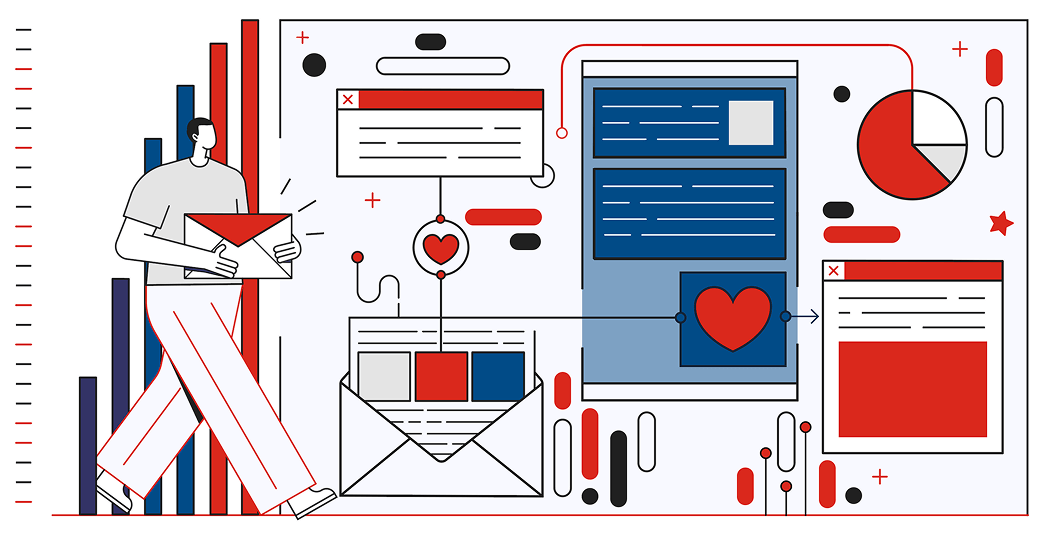
The effectiveness of digital ads is officially in question. Consumers are tired of the digital deluge and tuning out. An early 2025 study found that 81% of Gen Z respondents wish they could disconnect from digital devices more easily.[1] Meanwhile, costs for display ads and social media continue to rise despite dropping engagement.
This situation has left many digital-minded marketers wondering: Is digital the best way to reach customers at every stage? Should marketing strategies shift, and how? Is there something better out there?
In the quest to counter the challenges, a proven hero has emerged, redefined for a new era.
The Resurgence of Direct Mail
Direct mail has long been touted for its ability to stand out and engage. Yet modern marketers trained and experienced in the gems of the digital era—social media, search ads, email marketing—are unfamiliar and question mail’s relevance. For them, digital touts much greater ease, scale, and trackability. But today’s direct mail is a whole new breed.
Amid the digital overload, mail’s tactile nature is now more valuable than ever before. And innovations such as automation, scannable codes, and digital printing have put direct mail on par with the usability of digital assets, enhancing targeting and personalization and bridging the gap between physical and digital forms of media seamlessly.
Direct mail is not a replacement for digital tactics—indeed they work best together. Direct mail is the perfect catalyst to boost the effectiveness of digital communications, adding its unique essence to a message—the proven power of touch.
From the first moment at the mailbox and holding the weight of it, to the experience of opening it, direct mail is personal and hands-on. Rather than a fleeting moment lost in an endless scroll, it lingers, demanding attention and engaging the senses. In fact, research has shown that physical ads have a stronger connection to emotion and memory than digital ads. Marketing academic Jonathan Zhang, Ph.D., notes in a recent whitepaper on the impact of direct mail that when a person touches a physical object such as a mailpiece, it activates parts of the brain that digital media’s two-dimensional existence can’t reach.[2]
The paper points out that this connection is crucial to marketing, because emotional responses affect consumer decisions and brand loyalty. Mail provides the personal connection that’s lacking in the digital landscape.
Direct Mail Makes a Difference
The neuroscience is compelling but even more so is seeing the effect of direct mail in action. In a controlled field study conducted during Zhang’s research, involving a beauty and personal care e-commerce company, researchers looking to compare the effectiveness of direct mail to digital channels found that the ROAS for direct mail averaged around 55%, compared with 21% for a popular search-based advertising platform and 4.6 percent for social media ads.[3]
Direct mail customers purchased more frequently across a broader range of product categories, a sign of deeper engagement with the brand. Digital ads proved effective in spreading awareness, acquiring a large number of customers, albeit at a higher cost. To engage across the full customer journey, direct mail and digital together would be the strongest approach.
How does this translate into real-world campaigns? Zhang found that major brands are returning to direct mail. Premium home furnishings and kitchen goods retailers have reported significant increases in customer engagement and conversions after reintegrating direct mail into their marketing. Several digital-first retailers are using direct mail to help build loyalty among their online customers. Even a global e-commerce giant is embracing the savvy use of traditional direct mail catalogs at holiday time, tied right to online offerings.
Yes, Direct Mail Can Be Creative
For marketers wondering if direct mail is creative enough to engage consumers, modern mail offers innovations that not only command attention but also play perfectly with digital properties to captivate and convert.
Mail’s tactile nature presents the opportunity to create magical moments infused with a brand’s personality. Specialty inks, papers, and interactive designs treat the senses and bring a message to life. Only physical mail can evoke emotions with scent, delight with textures and unexpected folds, and give users something to hold onto and revisit.
Plus, advanced technologies like augmented reality and near field communication, among others, make mail immersive and exciting. Consumers can experience products and capabilities firsthand and head straight to purchase with confidence.
But What About Measurement?
Marketers’ biggest issue with direct mail is often tracking and measurement. In the age of real-time metrics, many don’t see how they can prove the effectiveness of a mail campaign. There are, however, established methods such as matchback analysis, promo codes, and personalized URLs, all of which can attribute conversions to a mailpiece. Modern mail also benefits from various technological innovations that have revolutionized how consumers interact with mail and the data that results.
The Omnichannel Advantage
As noted, direct mail is best as a complement to digital efforts, working in synergy to boost impressions, memorability, and overall campaign strength. When digital-only campaigns get lost in the shuffle, integrating mail is proving to play a crucial role in helping a brand stand out, connect in a powerful way, and nurture loyalty going forward.
Studies have demonstrated this in recent years, with companies experiencing an average 15% increase in sales when they combined direct mail with their digital strategies.[4]
Examples of integrated efforts include direct mail that is automatically triggered based on interaction with online channels or timing social promotions with the delivery of a catalog. The key is coordinated messaging that helps drive awareness and make campaigns feel highly personalized and relevant.
Key Takeaway
Digital alone can no longer do it all. The future of marketing is an intelligent mix of physical and digital, using the strengths of both to rise above the noise and create more impressions across touchpoints.
The research shows that direct mail recipients tend to have higher average order values and longer-lasting brand relationships than those acquired through purely digital channels. For today’s marketers who know digital best—and who are quickly coming up against its frustrating limitations—adding a tangible message into the mix can take moments from fleeting to memorable, from passive to immersive, from transactional to transformational.
The power to succeed may exist outside the comfort zone, but it’s within a hand’s reach for all.
Footnotes
keyboard_arrow_down- [1]“The Return of Touch Report: Reimagining Consumer Engagement in 2025,” The Harris Poll and Quad, May 13, 2025. arrow_right_alt
- [2]Dr. Jonathan Zhang, “The Tactile Advantage: How Direct Mail Is Outpacing Digital in Enhancing Consumer Experiences and Advertising Performance,” 2025. Independent research made possible by USPS. arrow_right_alt
- [3]Ibid. arrow_right_alt
- [4]“How Paper Catalogs Remain Relevant in a Digital Age,” Harvard Business Review, July 19, 2022. arrow_right_alt
 search
close
menu
search
close
menu



